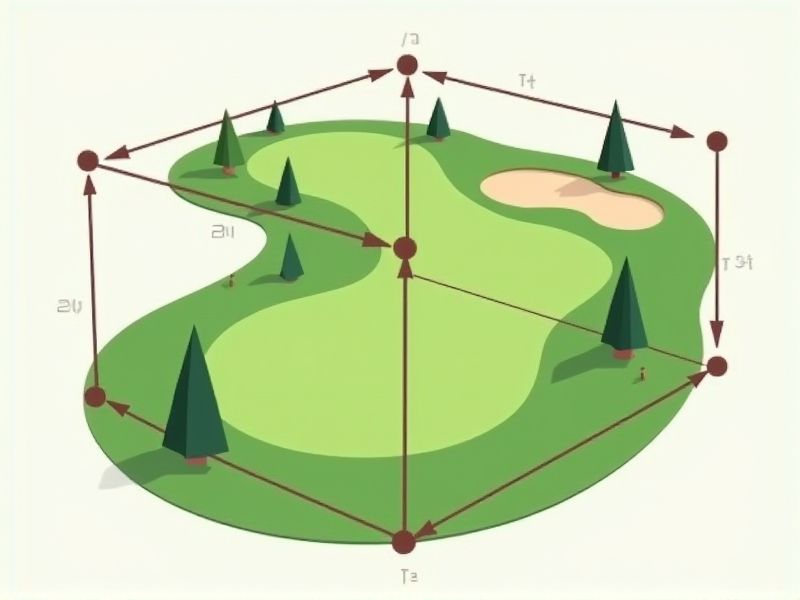
When designing or assessing a golf course, it's useful to know that a standard 18-hole course typically covers between 100 to 200 acres of land. The total length of the course usually ranges from 6,000 to 7,000 yards from the championship tees. Fairways generally have widths of about 30 to 50 yards, while each green is commonly 3,000 to 6,000 square feet in area. While these dimensions can vary based on terrain and design, they serve as helpful guidelines for planning a regulation golf course.
18 Holes
A standard golf course typically features 18 holes, offering a total length that ranges from 6,000 to 7,500 yards depending on the course difficulty and design. Each hole generally consists of a tee box, fairway, rough, and green, complete with a pin placement on the putting surface. Par for an 18-hole course usually sums up to 72 strokes, with variations accommodating par 3, 4, and 5 holes. Golf courses are often rated by their slope and course ratings, providing valuable metrics for players to understand course challenges and their playing capabilities.
Par 72
A standard golf course is typically designed with a Par of 72, comprising 18 holes that include a balance of par-3, par-4, and par-5 holes. The configuration usually features four par-3 holes, ten par-4 holes, and four par-5 holes, strategically laid out to challenge golfers of varying skill levels. Scoring under par on a course with a Par 72 indicates exceptional performance, demonstrating skill in driving, approach shots, and putting. Maintaining the course's greens and fairways is crucial to ensuring an optimal playing experience, impacting everything from your game strategy to overall enjoyment.
Total Yardage 6,500-7,000 Yards
A standard golf course generally spans a total yardage of 6,500 to 7,000 yards, catering to players of varying skill levels. This distance is typically divided among 18 holes, allowing for a diverse range of challenges and layouts, which can influence your strategy and club selection. For example, courses may feature par-3 holes averaging around 180 yards, while par-4 holes often range from 350 to 450 yards. Understanding these yardages can significantly enhance your performance and enjoyment of the game.
Fairway Width 30-50 Yards
A standard golf course typically features fairway widths ranging from 30 to 50 yards, providing a balance between challenge and playability for golfers of all skill levels. This width allows ample space for a variety of shot shapes while still demanding accuracy and strategy from players. Maintenance of fairways within this range is crucial to ensure optimal turf conditions and enhance the overall playing experience. Investing in proper agronomic practices can significantly improve the quality of the fairways, impacting your game positively.
Green Size 5,000-10,000 Square Feet
The standard green size for a golf course typically ranges between 5,000 and 10,000 square feet, influencing both the game's pace and strategy. Greens on the smaller end of this spectrum present a greater challenge, demanding precise approach shots and putting accuracy. Conversely, larger greens may offer more room for error but can present complex undulations that test your skills. When planning your golf course design or selection, consider how green size will impact gameplay and maintenance requirements.
Tee Box Dimensions 5-20 X 15-30 Feet
The standard dimensions for a golf course tee box typically range from 5-20 feet in width and 15-30 feet in length, providing ample space for players to practice their drives. This area is crucial as it defines the starting point of each hole, allowing golfers to establish their stance and angle before hitting the ball. Well-maintained tee boxes enhance overall course quality, contributing to the aesthetic and functional aspects of the game. Proper sizing ensures adaptability for various skill levels, accommodating both beginners and seasoned players effectively.
Bunker Dimensions 500-1,000 Square Feet
Bunkers on golf courses typically range in size from 500 to 1,000 square feet, contributing to the overall challenge and aesthetic appeal of the course. These sand traps are strategically positioned to test a golfer's skill, requiring precision in shot-making to avoid them. The depth and design of bunkers can also vary, enhancing their difficulty and the visual impact on the course layout. Proper maintenance of these areas is crucial, as it ensures consistent playability and upholds the standards expected in top-tier golfing environments.
Water Hazard Dimensions Variable
Water hazards on golf courses must meet specific dimensional standards to ensure safety and playability. Typically, the recommended width for these hazards ranges from 10 to 40 yards, depending on the course design and its intended challenge level. Depth can vary significantly, but a minimum of 1 to 2 feet is generally advisable to create an adequate barrier without interfering with gameplay. Understanding these dimensions is crucial for maintaining the integrity of your golfing experience while also adhering to regulatory guidelines.
Rough Height 1-4 Inches
A standard golf course often maintains rough grass height between 1 to 4 inches, significantly impacting playability and strategy. Keeping the rough within this range provides a challenging yet fair experience for players, promoting skillful navigation through varying lie conditions. This height allows for thicker turf, which can penalize inaccurate shots while still permitting recovery options for proficient golfers. For optimal course management, consistent monitoring and maintenance of the rough can enhance both aesthetics and competitive fairness.
Slope Rating 55-155
The Slope Rating of a golf course, typically ranging from 55 to 155, measures its difficulty for players compared to a course of par 72. A higher Slope Rating indicates a greater challenge for amateur players, while a lower rating suggests a more accessible experience. Understanding the Slope Rating allows you to assess how well your skills match the intended level of play at a specific course. When planning your game, consider this rating to select a course that aligns with your golfing abilities.
